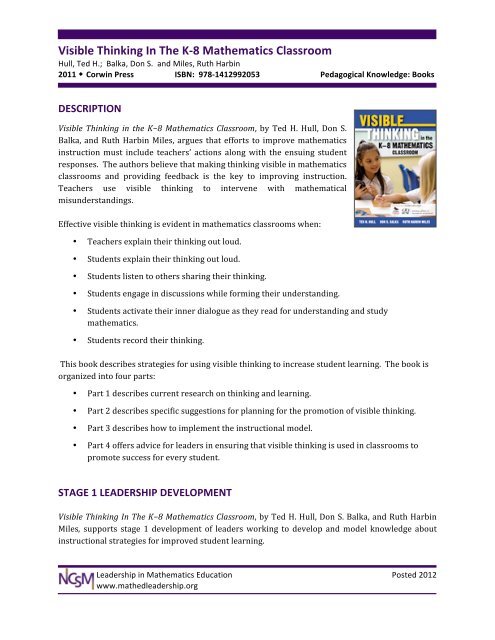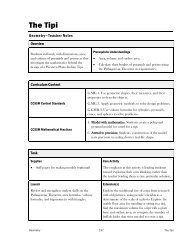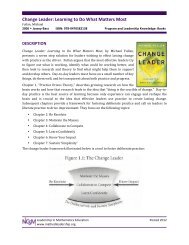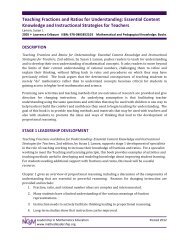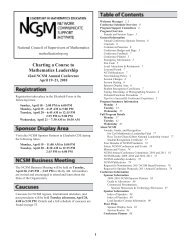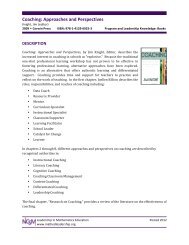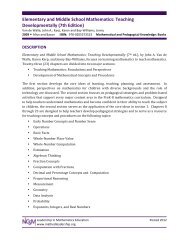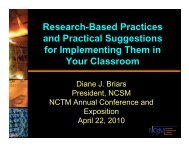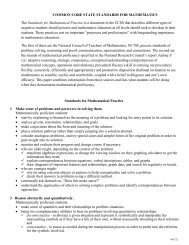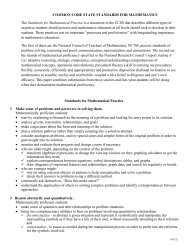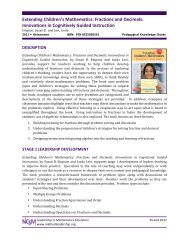Visible Thinking In The K-‐8 Mathematics Classroom
Visible Thinking In The K-‐8 Mathematics Classroom
Visible Thinking In The K-‐8 Mathematics Classroom
Create successful ePaper yourself
Turn your PDF publications into a flip-book with our unique Google optimized e-Paper software.
<strong>Visible</strong> <strong>Thinking</strong> <strong>In</strong> <strong>The</strong> K-<strong>‐8</strong> <strong>Mathematics</strong> <strong>Classroom</strong> <br />
Hull, Ted H.; Balka, Don S. and Miles, Ruth Harbin <br />
2011 w Corwin Press ISBN: 978-‐1412992053 Pedagogical Knowledge: Books <br />
DESCRIPTION <br />
<strong>Visible</strong> <strong>Thinking</strong> in the K−8 <strong>Mathematics</strong> <strong>Classroom</strong>, by Ted H. Hull, Don S. <br />
Balka, and Ruth Harbin Miles, argues that efforts to improve mathematics <br />
instruction must include teachers’ actions along with the ensuing student <br />
responses. <strong>The</strong> authors believe that making thinking visible in mathematics <br />
classrooms and providing feedback is the key to improving instruction. <br />
Teachers use visible thinking to intervene with mathematical <br />
misunderstandings. <br />
Effective visible thinking is evident in mathematics classrooms when: <br />
• Teachers explain their thinking out loud. <br />
• Students explain their thinking out loud. <br />
• Students listen to others sharing their thinking. <br />
• Students engage in discussions while forming their understanding. <br />
• Students activate their inner dialogue as they read for understanding and study <br />
mathematics. <br />
• Students record their thinking. <br />
This book describes strategies for using visible thinking to increase student learning. <strong>The</strong> book is <br />
organized into four parts: <br />
• Part 1 describes current research on thinking and learning. <br />
• Part 2 describes specific suggestions for planning for the promotion of visible thinking. <br />
• Part 3 describes how to implement the instructional model. <br />
• Part 4 offers advice for leaders in ensuring that visible thinking is used in classrooms to <br />
promote success for every student. <br />
STAGE 1 LEADERSHIP DEVELOPMENT <br />
<strong>Visible</strong> <strong>Thinking</strong> <strong>In</strong> <strong>The</strong> K−8 <strong>Mathematics</strong> <strong>Classroom</strong>, by Ted H. Hull, Don S. Balka, and Ruth Harbin <br />
Miles, supports stage 1 development of leaders working to develop and model knowledge about <br />
instructional strategies for improved student learning. <br />
Leadership in <strong>Mathematics</strong> Education <br />
www.mathedleadership.org <br />
Posted 2012
<strong>Thinking</strong> is a requirement for learning mathematics that leads teachers to ask the following <br />
questions: <br />
• What is mathematical thinking? <br />
• Who needs to do the thinking? <br />
• Can mathematical thinking be taught? <br />
• Does all of mathematics require thinking? <br />
• Is thinking about mathematics natural or manufactured? <br />
• Is there one correct thinking process or are there multitudes of processes? <br />
Specialists working to develop skills for making thinking visible to both students and teachers to <br />
develop understanding will find this book a useful resource. Reading and reflecting on the <br />
purposes and positive effects of visible thinking and the research-‐based teacher practices to make <br />
student thinking visible will provide valuable information for transforming practice. <strong>In</strong> addition, <br />
the benefits of visible thinking for students are explored, as seen below. <br />
Leadership in <strong>Mathematics</strong> Education <br />
www.mathedleadership.org <br />
Posted 2012
STAGE 2 LEADERSHIP DEVELOPMENT <br />
<strong>Visible</strong> <strong>Thinking</strong> <strong>In</strong> <strong>The</strong> K−8 <strong>Mathematics</strong> <strong>Classroom</strong>, by Ted H. Hull, Don S. Balka, and Ruth Harbin <br />
Miles, supports stage 2 development of leaders interested in the collaborative development and <br />
implementation of instructional strategies. This book might be used as a resource with teachers <br />
interested in developing instructional strategies to promote student understanding. Eight <strong>Visible</strong> <br />
<strong>Thinking</strong> Scenarios in Parts I and II show visible thinking examples in mathematics classrooms. <br />
<strong>The</strong>se classroom scenarios also show how teachers might intervene to use the examples of visible <br />
thinking effectively, quickly, and appropriately. Each scenario is organized into the subheadings: <br />
• Problem <br />
• <strong>Mathematics</strong> within the problem <br />
• What are students doing incorrectly? <br />
• What are students thinking and saying incorrectly? <br />
• Teacher intervention <br />
• How did the teacher use visible thinking to intervene and correct a misunderstanding? <br />
<strong>The</strong>se subheadings provide a useful framework for colleagues working together to discuss the <br />
mathematics and how problems may be presented to students. Discussing the students’ responses, <br />
what they do, think, and say, provides a model of anticipating student responses as an important <br />
part of planning and reflection. <strong>The</strong>se same subheadings might be useful as teachers reflect on <br />
their own classroom experiences. <br />
Part III provides examples of problems useful for implementing visible thinking in classrooms at <br />
the K-‐2, 3-‐5, and 6-<strong>‐8</strong> level. Three types of problems -‐ Brain-‐Teaser, Group-‐Worthy, and <br />
Transforming -‐ are presented. Each problem is organized by: <br />
• Problem <br />
• <strong>Mathematics</strong> within the problem <br />
• Setting the stage <br />
• Exploring <br />
• Summarizing <br />
• Formative assessment of visible thinking <br />
• Connections to strategies, actions, and conditions <br />
Leadership in <strong>Mathematics</strong> Education <br />
www.mathedleadership.org <br />
Posted 2012


